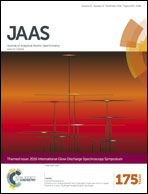Atomic spectrometry update: review of advances in the analysis of metals, chemicals and functional materials
Abstract
This ASU review focuses on developments in applications of atomic spectrometry to the characterisation of metals, chemicals and functional materials. While each of these application categories is very distinct in terms of the analytical challenges posed, there are a number of common themes than can be identified from an examination of the relevant literature appearing over the review period. The traditional atomic spectrometry techniques (e.g. AAS, OES, XRF, ICP-MS) are relatively mature, but reports continue to appear that seek to address perceived limitations in sensitivity in certain applications, but increasingly more frequently in relation to sample handling and preparation/extraction methodologies, validation and creation of SRMs and methods. However, it is equally clear that because of that very maturity such techniques are more often cited as analytical reference methods to support the development of other approaches (e.g. GD-OES, GD-MS, PIXE, PIGE, RBS, SEM-EDS, SIMS, TXRF, micro- and macro-XRF, XAS, XPS) that provide either direct sampling or depth and lateral elemental profiling capabilities. Consequently, a variety of techniques may now be routinely applied within an individual study to characterise samples to the extent it is hard to comment critically on the particular analytical novelty that lies at the heart of the work. It is fair to say that in some cases, the significance of the research now involves revealing the features of the sample (including examining surface modifications, coatings, thin films and multilayers, or even the characteristics of a device, functional component, or object, or complex mixture) rather than in the development of the analytical approach itself. That said, certain trends in technique development still expand the range of applications that can be addressed. For example, interest in LIBS continues to command attention and is heavily cited in most application sections of this review. The technique offers certain unique advantage for elemental analysis in rapid direct sampling, portability and operating in remote and harsh environments (including industrial production) where low level detection is not essential. Clearly sensitivity remains the Achilles' heel for LIBS but developments in measurement technique such as pulse delay are resulting in better optimised procedures. The development in laser solid sampling technology is providing benefits applicable to other techniques such as ICP-MS and newer variants such as laser ionisation MS. Indeed, lasers, flames, plasmas and other electrical discharges have been used regularly in the fabrication of samples. The atomic spectrometry techniques with which they have been associated are now employed to study such production processes in situ. The development of nanomaterials has given rise to new approaches to particle size distribution and single particle characterisation where the atomic spectrometric determination produces a size rather than a concentration. There is evidence too in the review of research work going on to understand the environmental consequences of the widespread use of new technologies using data analysis approaches to examine source, provenance or impact. Consequently, while the fundamental analytical questions: “What?” and “How much?” continue to be relevant to researchers increasingly these must now be qualified in many situations by providing answers to enquiries such as “Where?” and “How big (or small)?”.

- This article is part of the themed collection: Atomic Spectrometry Updates

 Please wait while we load your content...
Please wait while we load your content...